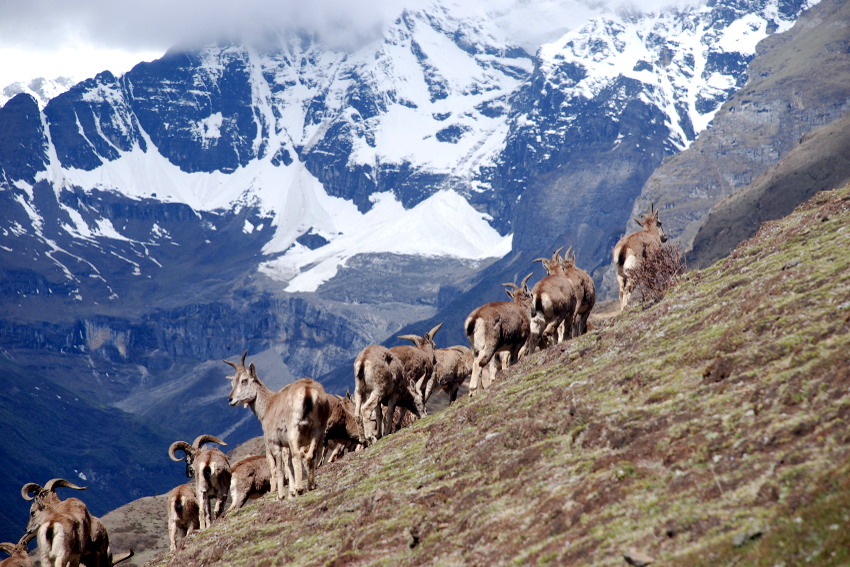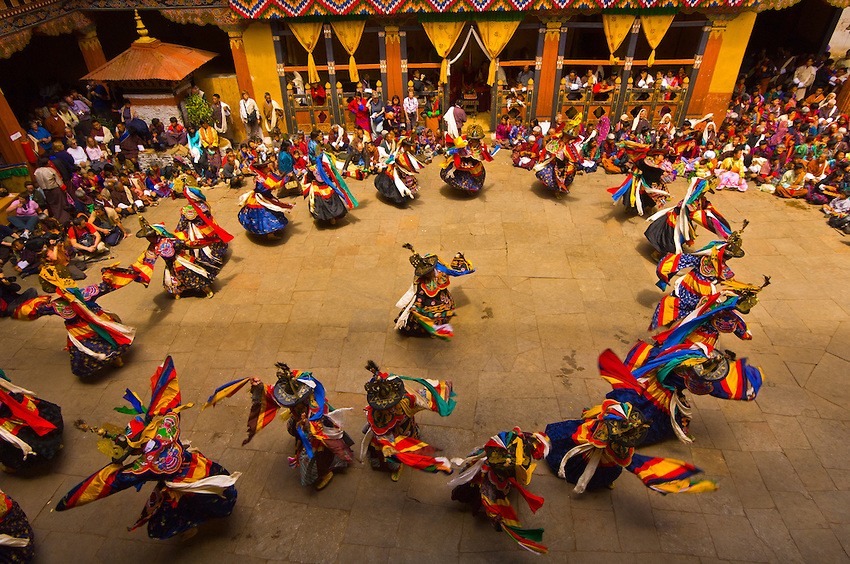Lunana Snowman Trek (23 days)
23 days, 17 days of very strenuous trekking, unmatched cultural and wilderness experience!
When looking at the multitude of treks available in the Himalayas today, a select few stand alone at the top. Our Laya & Lunana trek is clearly in this category. We’ll cross a total of seven passes, four of them well over 16,000′, as we pass through the highest and wildest corner of Bhutan. We’ll see the tallest, most dramatic Himalayan peaks in Bhutan, and get to meet the friendly villagers who live in their shadows. Turquoise-tinted lakes and high altitude wildlife like the snow leopard and blue sheep round out the trek’s highlights.
This epic adventure begins with a drive from the airport in Paro to Thimphu, the low-key capital of Bhutan. We then continue on to Punakha to begin our great adventure.
Our trek route takes us up the Mo Chu (River) to its very source near Laya, at the foot of Gangchey Ta (22,290′) which forms the border with Tibet. The people of Laya are rarely visited by outsiders, live semi-nomadic lives in their black yak hair tents, and are extremely care-free and welcoming. The women wear their hair long-unusual in Bhutan, and wear waterproof robes made from the wool of goats, sheep, and yaks. After enjoying our short visit with the Layaps, we head east over the first series of passes to gain access to the most inaccessible corner of this inaccessible kingdom, Lunana. To the north, along the Tibetan border, the highest peaks sit majestically, turquoise lakes at their feet in obeisance.
We now drop down into the high Lunana Valley, sprinkled with little villages peopled by folks as hardy and contented as will be found anywhere. Their warmth and hospitality will be as intense as their surprise at seeing our arrival in their villages. The background for these days of revelry will be the most dramatic mountain scenery to be found in Bhutan, stunning snow-capped peaks and the high, wild valleys at their feet.
With mixed emotions, we must eventually leave this special, other-worldly idyll, and prepare for the journey back out, which involves four passes, the highest of them just under 17,000′. The days are mostly long and hard, through pristine wilderness dotted with crystal lakes. After nearly a week’s trek, we arrive at the roadhead near Tongsa and drive to Paro for our final, more sublime adventure. Our final day is spent in ascending to-and standing in wrapt awe before-the one-of-a-kind Taktsang Dzong, perched dramatically atop a 2,000′ sheer cliff. We fly out from Paro.
Grade: Ass-kickin’ Strenuous.
Best Season: August-October
Day 01: Arrive Paro
On Arrival at Paro airport received by Druk Executive Travel representative and transfer to Thimphu. Overnight at the hotel in Thimphu.
Day 02: Thimphu
Full day sightseeing in Thimphu valley. Visit Traditional Medicine Institute where centuries old indigenous medicines are still practised, the Painting School which is particularly famous for the thankha paintings and National Library that house ancient Buddhist texts manuscripts. Also visit Handicrafts Centre for exotic weaves in wool, silk and cotton, basket ware, silver jewellery, Thangkas and other traditional crafts of the kingdom.
Overnight at the hotel in Thimphu.
Day 03: Thimphu – Punakha, sightseeing
Today we drive to Punakha, the old winter capital. The drive takes about 3 hours and crosses the 3100m high Dochu La. If the weather is clear, there are wonderful Himalayan views from the pass and one can get a panoramic view of the eastern Himalayan peaks and the enticing view of the Lunana route.
On the way to Punakha, at Metshina, we will stop for a short walk to Chimi Lakhang. It is a pleasant 20min stroll through fields to the temple that occupies a commanding position in the centre of the valley. The temple has special significance due to its association with Lama Drukpa Kunley, one of the most popular saints in Bhutan. From here, we proceed to Punakha and the imposing dzong which lies at the confluence of the Mo and Pho rivers. The large fortress with its temples, hall and towers overlooks the town and provides excellent views.
Overnight at the hotel in Punakha.
Day 04: Drive to Tashithang, Trek to Damji
After an early breakfast at the hotel, drive on to Tashithang (alt. 1600m) following the Mo Chu river. The trek starts by the riverside, following a well made path through semitropical forests. This part of the area is quite wet and one has to be careful of leeches. Also for flower lovers there is abundant of wild orchids here. The days walk is fairly gentle climbing upto Damji village. Camp at Damji at the altitude of 2,250m. walking time 5/6 hours.
Day 05: Damji – Gasa
The path continues through sub-tropical forests and villages upto Gasa Tshachu(hot springs). Tshachu is a famous place where people from all over the country come to have bath, due to its curative powers. Here there are four pools of different temperature from mild to hot. Hot lunch will be served close to spring. After lunch two hours stiff climb to Gasa Dzong. Camp below the Dzong at an altitude of 2,900m. walking time 6/7 hours.
Day 06: Gasa – Koena
After breakfast, visit the Dzong which was built in the in 17th century, to protect the valley against the Tibetan invaders. The path starts with stiff climb upto Belela pass (3,900m) through bamboo, rhododendron, Juniper and Fir forests. Then descend for about half an hour to a camp at Koena Chamsa at an altitude of 3,050m. Walking time 6,7 hours.
Day 07: Koena – Laya
The trail starts by descending to the bank of Mo Chu river. Lunch will be served at the side of the bridge, across the river. After lunch climb up gradually to Laya crossing the army camp. Overnight camp at an altitude of 3,800m. Walking time 8/9 hours.
Day 08: Laya – Rest day/acclimatisation
One can go around the villages, visiting houses and the people. Laya people are very friendly and will happily pose for photographs. Women of Laya wear a special dress and typical bamboo hats decorated with turquoise silver ornaments. Cultural evening with dances performed by local girls.
Day 09: Laya – Rhodophu
From Laya we descend to army camp and continue following the river till the turn off point to Rhodophu. After lunch continue the climb through rhododendron bushes till we reach the camp at an altitude of 4,350m. Walking time 8/9 hours.
Day 10: Rhodophu – Tarina
Today is the longest day of the trip and is important to start early morning. Start at about 5 a.m. by climbing to Tsimola (4,700). After crossing the first pass and the little summit, one can superb view of Lunana, mount Chomolhari and mount Jichu Drake. The path is flat for another four hours till climb to Kangla Karchula pass(5,080) is started. The view from the path is breathtaking and whole range of mountains including Masagang, Tsendegang, Terigang can be seen. After the path, it is very long descent to Tarina valley. Camp at an altitude of 3,980m. Walking time 10/11 hours.
Day 11: Tarina – Woche
The day is much easier as the path follows the river down valley. Lunch at lowest point (3,500m). After lunch climb up about 300m to the village of Woche. Camp at altitude 3,800m. Walking time 6/7 hours.
Day 12: Woche – Lhedi
The trek starts through Juniper and Fir forests and further ahead through rhododendron bushes. Climb upto Keche La pass (4,480m) where one can have the great view of the mountains.
After the pass descend to the riverside walking through the village with stunning view of the Table mountains and others surrounding peaks. Follow the river till Lhedi village, which is one of the main source of Pho Chu (river). Camp at an altitude of 3,650m
Day 13: Lhedi – Thanza
The trek continues following the river, rising gradually to Choejang village. After lunch, visit the Choejong Dzong and continue walking towards the wide valley. Cross the bridge to reach Thanza camp at an altitude of 4,000m. walking time 7/8 hours.
Day 14: Rest day at Thanza
In Thanza, visit the village of the Lunaps- as they are known; you may mix and interact with the people of Thanza or hike in and around the camp or climb up the ridge for fascinating view of the lakes and mountains. Overnight in camp.
Day 15: Thanza – Tshochena
From Thanza to Tshochena, it is a distance of about 18kms taking about 6-7 hours. Alt.15744ft/4800m. Cross the Jazela pass alt. 16564ft/5050m. Overnight in camp.
Day 16: Tshochena – Jichudramo
Jichudramo is about 14kms away from Tshochena and takes about 4-5 hours. The trail crosses another pass known as the Lojula pass at alt. 16203ft/4949m. Overnight in camp.
Day 17: Jichudramo – Chukarpo
A relatively short distance of about 15kms and takes about 4-6 hours. The highest altitude reached today is at Rinchenzoe pass at alt. 16859ft/5140m. Overnight in camp.
Day 18: Chukarpo – Tampetso
An interesting hike today covering a distance of about 20kms in about 7-8 hours. Cross Tampela pass at alt. 15015ft/4550m. En route, cross the Umtso lake in which religious treasures were found by Terton (treasure finder) Pemalingpa. Overnight in camp.
Day 19: Tampetso – Maurothang
Today the trek goes all the way downhill through rhododendron forests till you reach the camp. The camp is near the Nikkachu River. Overnight in camp.alt. 11840ft. Distance covered today is about 14kms in 5 hours.
Day 20: Maurothang – Nikachu Zam (Sephu village)
A long hike today covering a distance of 23kms in about 6-7 hours. Altitude decreases to 8692ft/2650m. The trail passes through fields and the village of Sephu. Camp is near the village of Sephu.
Day 21: Nikachu Zam – Thimphu
Continue walking for another half an hour to arrive at Nikachu Zam where you meet the motor road. Your pick up transport awaits here from where you will be picked up and transferred to Thimphu. The drive takes about 5-6 hours via Pelela and Dochula passes. On arrival, check into your hotel.
Overnight at the hotel in Thimphu.
Day 22: Thimphu – Paro
Drive the winding mountain road to Paro (1 ½ hrs. drive). Afternoon sightseeing includes visit to; Ta Dzong which is now a natural history museum, the Rinpung Dzong built in 17th century to defend the valley against the Tibetan invaders and which is now used as an administrative center and home of monastic community. Also visit to Drugyel dzong, situated at the end of Paro vallery and Kyichu Lhakhang the oldest of the Kingdom’s monasteries.
Overnight at the hotel in Paro.
Day 23: Paro depart
After early breakfast in the hotel, drive to the Paro airport for onward flight to Bangkok.

